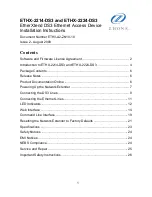
This section contains the following topics:
•
•
on page 38
•
on page 38
Backbone area
The backbone area consists of the following network types:
• networks and attached routers not in any other area
• routers that belong to multiple areas
The backbone is usually contiguous, but you can configure virtual links to create a
noncontiguous area.
Configure virtual links between any two backbone routers that use an interface to a common
nonbackbone area. Virtual links belong to the backbone and use intra-area routing only. For a
description of virtual links, see
The backbone distributes routing information between areas. The backbone area topology is
invisible to other areas. Other area topologies are invisible to the backbone area.
The OSPF routing algorithm finds the paths with the lowest cost. The topology of the backbone
dictates the backbone paths used between areas. The algorithm examines the routing table
summaries for each connected area boarder router (ABR) to select inter-area paths. The OSPF
behavior is modified, according to OSPF standards so that OSPF routes are not learned
through an ABR unless the router connects to the backbone or through a virtual link.
Stub area
You configure stub areas at the edge of the OSPF routing domain. Stub areas use one ABR.
A stub area receives no LSAs for routes outside the area, reducing the size of the link-state
database. The ABR examines packets destined for outside the stub area before it forwards
the packet to the destination.
The OSPF routing algorithm treats the network behind a passive interface as a stub area that
forms no adjacencies. The OSPF routing algorithm advertises the network into the OSPF area
as an internal route.
Not so stubby area
A not so stubby area (NSSA) replaces LSAs with a default route to prevent external LSAs from
flooding the area. An NSSA can import small stub (non-OSPF) routing domains into OSPF.
Like stub areas, NSSAs are at the edge of an OSPF routing domain. Non-OSPF routing
domains attach to the NSSAs to form NSSA transit areas. The NSSA border router performs
manual aggregation by accessing the addressing scheme of small stub domains.
Neighbors
In an OSPF network, any two routers with an interface to the same network are neighbors.
Routers use the Hello Protocol to discover neighbors and to maintain neighbor relationships.
IPv6 routing fundamentals
38 Configuration — IPv6 Routing
November 2010
Summary of Contents for ERS 8600 series
Page 14: ...New in this release 14 Configuration IPv6 Routing November 2010...
Page 78: ...IPv6 routing configuration 78 Configuration IPv6 Routing November 2010...
Page 132: ...Basic IPv6 configuration using the ACLI 132 Configuration IPv6 Routing November 2010...
Page 176: ...IPv6 routing configuration using the CLI 176 Configuration IPv6 Routing November 2010...
Page 194: ...IPv6 routing configuration using the ACLI 194 Configuration IPv6 Routing November 2010...
Page 206: ...IPv6 DHCP Relay configuration using the CLI 206 Configuration IPv6 Routing November 2010...
Page 238: ...IPv6 VRRP configuration using the CLI 238 Configuration IPv6 Routing November 2010...
Page 250: ...IPv6 VRRP configuration using the ACLI 250 Configuration IPv6 Routing November 2010...
Page 262: ...IPv6 RSMLT configuration using the CLI 262 Configuration IPv6 Routing November 2010...
Page 268: ...IPv6 RSMLT configuration using the ACLI 268 Configuration IPv6 Routing November 2010...
Page 306: ...Multicast protocol configuration using the ACLI 306 Configuration IPv6 Routing November 2010...
Page 344: ...IPv6 traffic filter configuration using the ACLI 344 Configuration IPv6 Routing November 2010...
Page 398: ...CLI show commands 398 Configuration IPv6 Routing November 2010...
















































